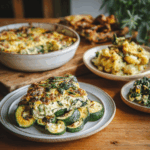Follow Me On Social Media!
Whole Milk Ricotta Cheese: Creamy, Classic, and Easy to Make at Home
If you’ve never tried making your own whole milk ricotta cheese, you’re in for a creamy, comforting surprise. This versatile, melt-in-your-mouth cheese adds richness to lasagna, elegance to pasta, and softness to baked goods. In this guide, we’ll explore what makes whole milk ricotta so special, how to make it at home, and how to use it in recipes your family will love. Whether you’re new to cheese-making or simply craving more flavor, you’ll discover that whole milk ricotta cheese is an easy upgrade to elevate your kitchen creations—without complicated steps or special tools.
The Story Behind My Love for Whole Milk Ricotta Cheese
A Kitchen Memory That Stuck
Every time I make whole milk ricotta cheese, I’m taken back to my grandmother’s sunny kitchen in rural Georgia. I was a little girl standing on a stool, watching her stir a big pot of milk with the patience only grandmothers have. I remember her saying, “When the milk listens, the curds will come.” I didn’t understand what she meant back then, but I do now. It’s not just cheese—it’s comfort, care, and tradition in every spoonful.
These days, I make my own ricotta in a much more modern kitchen, but the essence remains the same. The soft texture and fresh flavor remind me of those slow, thoughtful moments. Over time, I’ve refined my own version, using whole milk to make a richer, creamier ricotta that’s ideal for everything from meatloaf muffin recipes to simple crostini.
What Makes Whole Milk Ricotta Cheese So Special?
Whole milk ricotta cheese isn’t your average dairy product—it’s a standout for its luscious consistency and delicate flavor. Unlike traditional ricotta made from whey, this version starts with whole milk, which gives it a much fuller texture and a slightly sweet, nutty flavor. The fat content in whole milk is the secret to its creamy magic. It makes every bite soft, luxurious, and deeply satisfying.
In fact, when I’m making a family-favorite dish like chicken cutlet sandwiches, a dollop of fresh ricotta tucked inside adds a melt-in-your-mouth surprise. Or in a pasta bake, it helps bind ingredients with just enough richness without overwhelming the dish.
Using whole milk instead of skim or low-fat milk also means fewer additives and more control over the final result. That’s one of the biggest reasons I recommend it for anyone looking to cook with more intention—and better ingredients. From savory mains to sweet treats, homemade whole milk ricotta cheese opens up a world of culinary possibilities that just taste like home.

The Perfect Lasagna Starts with Whole Milk Ricotta Cheese
Why Whole Milk Ricotta Is a Lasagna Game-Changer
Lasagna is one of those dishes where every layer matters. And trust me—when you use whole milk ricotta cheese, it shows. The richness of whole milk adds body and creaminess that lower-fat ricotta just can’t match. It doesn’t get watery in the oven, and it holds its shape between the noodles, creating a dreamy, melt-in-your-mouth bite.
When I’m making my signature three-cheese lasagna, I always start with a fresh batch of homemade ricotta. It spreads easily without clumping and infuses the entire dish with a smooth, mellow flavor. Unlike pre-packaged options that can taste bland or gritty, whole milk ricotta gives each forkful the kind of comfort that reminds you why lasagna is a classic.
Looking for the best partner for ricotta in savory dishes? Try it with something bold, like easy soup recipes—a dollop stirred in adds instant creaminess.
How to Use Ricotta in Your Lasagna Layers
When it comes to lasagna, balance is everything. I like to mix my whole milk ricotta cheese with a single egg, a pinch of sea salt, black pepper, and fresh chopped parsley. Some people add parmesan or shredded mozzarella here, but I find it’s better to let the ricotta shine on its own.
Spread a generous layer of this mixture over each sheet of pasta, then add sauce and mozzarella. Repeat until your baking dish is filled, then top with extra cheese and bake until bubbly and golden. The result? A lasagna that’s hearty, rich, and bursting with flavor.
Ricotta isn’t just filler—it’s the heart of this dish. Its creamy texture and subtle taste help balance the acidity of the sauce and the saltiness of the cheese. I often pair this dish with a bright salad or even serve it alongside chicken parmesan for big family gatherings.
Whether you’re cooking for Sunday dinner or prepping ahead for the week, lasagna made with whole milk ricotta cheese is the kind of meal that brings people to the table—and keeps them there.

Beyond Lasagna: Delicious Ways to Use Whole Milk Ricotta Cheese
Savory Uses for Everyday Meals
While lasagna may be the headliner, whole milk ricotta cheese has serious range in the kitchen. Its creamy texture and subtle flavor make it ideal for both hearty meals and light bites. One of my favorite weekday dishes is a simple ricotta toast. I spread it thick over grilled sourdough and top it with roasted tomatoes or a drizzle of olive oil and cracked pepper. It’s fast, satisfying, and absolutely comforting.
You can also stir ricotta into scrambled eggs or stuff it into omelets for extra richness without overwhelming flavor. I often use it as a base in savory muffins, much like in my meatloaf muffin recipe, to keep things moist and flavorful. It’s even delicious dolloped into soups—adding it to a bowl of hot creamy parmesan sausage soup transforms it into something indulgent and elegant.
And if you love stuffed pasta, use ricotta as the filling in ravioli, manicotti, or shells. Add spinach, lemon zest, or herbs for a flavor boost. The whole milk base gives the filling body, so it won’t leak or become watery.
Sweet Ideas and Baked Treats
Whole milk ricotta cheese also shines in sweet recipes. Its soft, spreadable texture makes it a natural fit for desserts, pancakes, and baked goods. I love using it in muffins, like in my sweet potato muffin recipe, where it adds moisture and a soft crumb that keeps people guessing: “What’s your secret ingredient?”
For a no-bake treat, mix ricotta with a little honey, cinnamon, and fresh berries. Spoon it into parfait glasses or spread it over warm crepes. You can even whip it with maple syrup and vanilla for a luscious cheesecake-like filling that’s light and lovely.
Another trick? Use it in place of cream cheese in frosting for a lighter touch. I’ve even stirred it into pancake batter for fluffier results—my weekend guests always ask what made the difference.
With just one bowl of whole milk ricotta cheese, you can go sweet or savory, rustic or refined. That’s what makes it one of my favorite ingredients—it’s endlessly flexible and always delivers comfort, flavor, and nourishment in every spoonful.
Frequetly Asked Questions
What is whole milk ricotta?
Whole milk ricotta is a fresh, creamy cheese made by curdling whole milk with an acid such as vinegar or lemon juice. Unlike traditional ricotta made from whey, this version uses the full-fat content of whole milk to produce soft, rich curds. It has a mild, slightly sweet flavor and a smooth texture, making it ideal for both savory dishes like lasagna and sweet treats like muffins or parfaits.
Can you make ricotta with milk?
Yes, you can absolutely make ricotta with milk—specifically whole milk for the creamiest results. Simply heat the milk, add an acid (like lemon juice or vinegar), and strain the curds that form. You don’t need any special equipment or cheese cultures. Whole milk is the best choice because it creates soft, flavorful curds that hold their texture well in cooking and baking.
Is whole milk ricotta good for lasagna?
Whole milk ricotta cheese is ideal for lasagna. Its high fat content gives it a rich, creamy texture that blends beautifully between pasta layers without becoming runny. It also enhances the overall flavor, creating a satisfying bite that balances well with tomato sauce, mozzarella, and seasonings. For best results, mix the ricotta with a little egg and herbs before layering.
Can you use whole milk to make cheese?
Yes, whole milk is excellent for making a variety of cheeses, especially fresh ones like ricotta, paneer, or mozzarella. The fat in whole milk helps form smooth, tender curds that give cheese a soft mouthfeel and rich flavor. Avoid ultra-pasteurized milk, which won’t curdle properly. Always choose high-quality whole milk for the best texture and taste.
Conclusion
Whole milk ricotta cheese is more than just a versatile ingredient—it’s a connection to tradition, comfort, and creativity in the kitchen. Whether you’re folding it into lasagna, whipping it into a sweet spread, or baking it into tender muffins, its creamy texture and mild flavor elevate any dish. Making your own batch at home is not only easy, but deeply rewarding. From my kitchen in Savannah to yours, I hope this guide inspires you to try something new and make your meals even more nourishing and memorable. Sometimes, it’s the simple things—like whole milk and a little heat—that bring the most joy.





